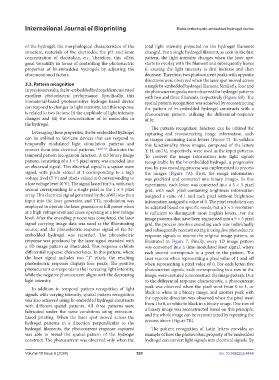Page 533 - IJB-10-6
P. 533
International Journal of Bioprinting Bacteriorhodopsin-embedded hydrogel device
of the hydrogel, the morphological characteristics of the total light intensity projected on the hydrogel filaments
structure, materials of the electrodes, the pH and ionic changed. For a single hydrogel filament, as seen in the first
concentration of electrolyte, etc. Therefore, this offers pattern, the light intensity changes when the laser spot
great versatility in terms of controlling the photoelectric starts to overlay with the filament and subsequently leaves
properties of br-embedded hydrogels by adjusting the it, causing the light intensity to first increase and then
aforementioned factors. decrease. Therefore, two photocurrent peaks with opposite
directions were observed when the laser spot moved across
3.3. Pattern recognition a single br-embedded hydrogel filament. Similarly, four and
In previous results, the br-embedded hydrogel demonstrated six photocurrent peaks were observed for hydrogel patterns
excellent photoelectric performance. Specifically, this with two and three filaments, respectively (Figure 6B). The
biomaterial-based photosensitive hydrogel-based device spatial pattern recognition was achieved by reconstructing
can respond to changes in light intensity, and this response the pattern of br-embedded hydrogel constructs with a
is related to two factors: (i) the amplitude of light intensity photocurrent pattern, utilizing the differential response
changes and (ii) the concentration of br molecules in of br.
the hydrogel.
The pattern recognition function can be utilized for
Leveraging these properties, the br-embedded hydrogel capturing and reconstructing image information, such
can be utilized to fabricate devices that can respond to as images containing Latin letters (Figure 7). To validate
temporally modulated light stimulation patterns and this functionality, three images, composed of the letters
convert them into electrical patterns. Figure 6A illustrates the T, H, and U, respectively, were used as the input patterns.
temporal pattern recognition function. A 1D binary image To convert the image information into light signals
pattern, consisting of a 1 × 5 pixel array, was encoded into recognizable by the br-embedded hydrogel, a progressive
an electrical signal. This electrical signal is a square wave row-by-row encoding process was implemented to process
signal, with pixels valued at 1 corresponding to a high the images (Figure 7A). First, the image information
voltage level (5 V) and pixels valued at 0 corresponding to was pixelized and converted into binary images. In this
a low voltage level (0 V). The signal lasted for 5 s, with each experiment, each letter was converted into a 5 × 5 pixel
second corresponding to a single pixel in the 1 × 5 pixel grid, with each pixel containing brightness information
array. This electrical signal generated by the AWG was then assigned a value of 1 and each pixel without brightness
input into the laser generator, and TTL modulation was information assigned a value of 0. The pixel resolution can
employed to operate the laser generator at full power when be adjusted based on specific needs, but a 5 × 5 resolution
at a high voltage level and cease operating at a low voltage is sufficient to distinguish most English letters. For the
level. After the encoding process was completed, the laser image patterns that have been segmented into a 5 × 5 pixel
signal carrying image data was used as the illuminating grid, the process involves encoding each row individually
source, and the photoelectric response signal of the br- and subsequently reconstructing it using five photoelectric
embedded hydrogel was recorded. The photoelectric response signals to restore the original image pattern, as
response was produced by the laser signal encoded with illustrated in Figure 7. Finally, every 1D image pattern
a 1D image pattern as illustrated. This response exhibits was converted into a time-modulated laser signal, where
differential response characteristics. In this pattern, where each second corresponds to a pixel in the pattern. The
the laser signal includes two “1” pixels, the resulting laser was on when representing a pixel value of 1 and off
photoelectric response displays four peaks. The positive when representing a pixel value of 0. For each letter, five
photocurrent corresponds to the increasing light intensity, photocurrent signals, each corresponding to a row in the
while the negative photocurrent aligns with the decreasing image, were captured to reconstruct the image pattern. Due
light intensity. to the differential response characteristic, a photocurrent
In addition to temporal pattern recognition of light peak was observed when the pixel went from 0 to 1, or
signals with varying intensity, spatial pattern recognition black to white in a binary image, and another peak with
was also achieved using br-embedded hydrogel constructs the opposite direction was observed when the pixel went
with different spatial patterns. All three patterns were from 1 to 0, or white to black in a binary image. One row of
fabricated under the same conditions using extrusion- a binary image was reconstructed based on this principle,
based printing. When the laser spot moved across the and the whole image can be reconstructed by repeating the
process above (Figure 7B).
hydrogel patterns in a direction perpendicular to the
hydrogel filaments, the photocurrent response captured The pattern recognition of Latin letters provides an
was able to reveal the spatial pattern of the hydrogel example of how the photovoltaic property of br-embedded
construct. The photocurrent was observed only when the hydrogel can convert light signals into electrical signals. By
Volume 10 Issue 6 (2024) 525 doi: 10.36922/ijb.4454

